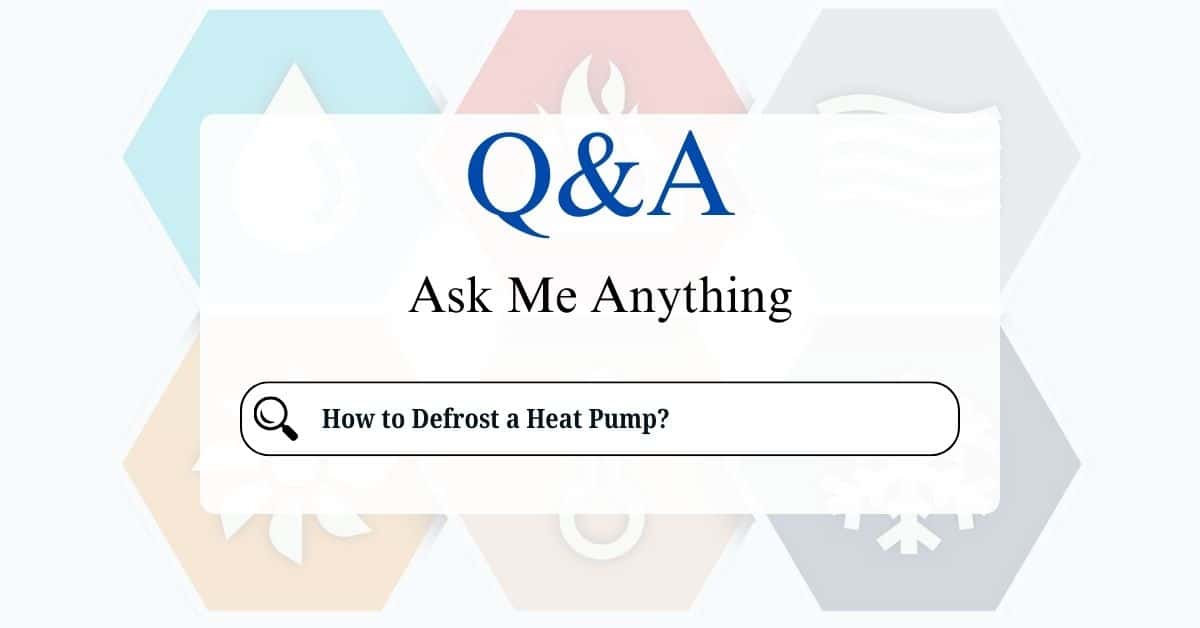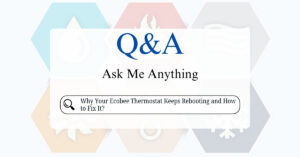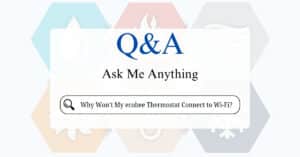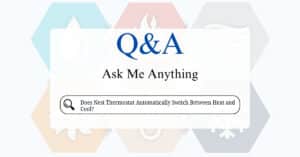Heat pumps are incredibly efficient for both heating and cooling, but they can sometimes encounter a frosty problem: ice buildup on the outdoor unit. This is a normal occurrence, especially in colder climates, and your heat pump is designed with a defrost cycle to handle it. However, sometimes you might need to assist the process. This friendly guide will explain why heat pumps frost up, how the defrost cycle works, and when you might need to manually defrost your unit.
Why Heat Pumps Frost Up?
In heating mode, your heat pump extracts heat from the outside air. As the outdoor coil absorbs this heat, it can get quite cold, especially when the outside temperature is low and the humidity is high. When the coil’s temperature drops below freezing (32°F or 0°C), moisture in the air can condense and freeze onto it, forming frost or ice.
How the Heat Pump Defrost Cycle Works?
Fortunately, heat pumps are designed with a built-in defrost cycle to automatically remove this frost. Here’s a simplified explanation of how it works:
- Reversing the Refrigerant Flow: The heat pump temporarily reverses its operation, essentially switching to cooling mode. This sends hot refrigerant through the outdoor coil, melting the frost.
- Activating Electric Resistance Heaters (Sometimes): Some heat pumps also activate electric resistance heaters (auxiliary heat) during the defrost cycle to prevent a blast of cold air from entering your home.
- Short Duration: The defrost cycle typically lasts only a few minutes.
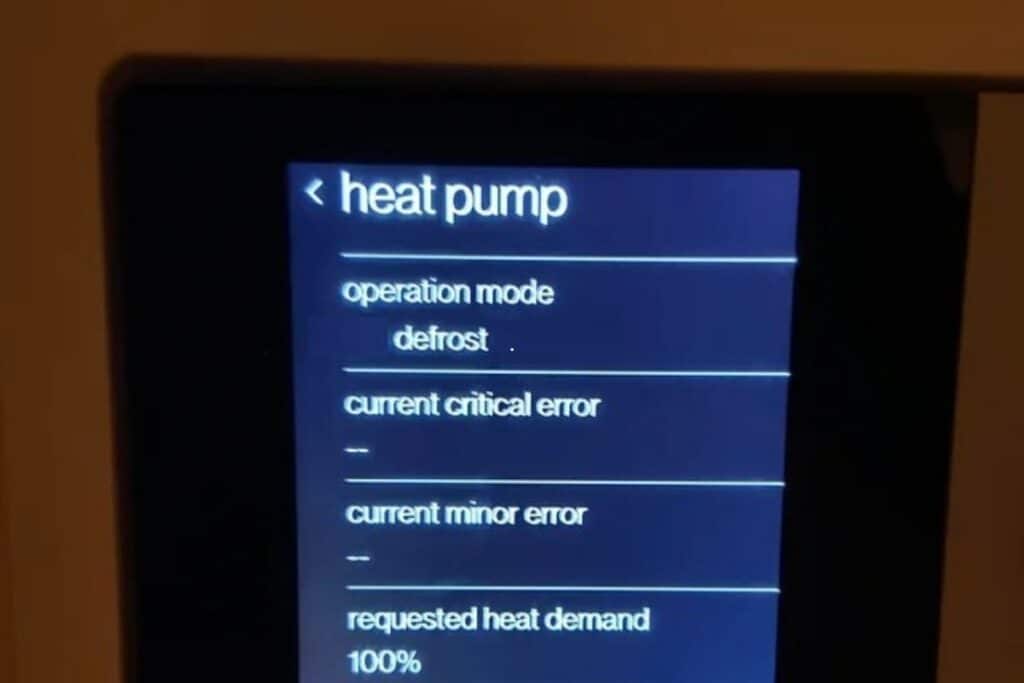
What You Might Notice During a Defrost Cycle
- Steam or Fog: You might see steam or fog rising from the outdoor unit as the frost melts.
- Gurgling or Hissing Sounds: You might hear gurgling or hissing sounds as the refrigerant flow reverses.
- Temporary Cool Air: You might feel a brief blast of cool air from the indoor vents as the system switches to cooling mode for defrosting. This is why some systems activate auxiliary heat to compensate.
How to Defrost a Heat Pump
Here’s a step-by-step guide to defrosting a heat pump manually and ensuring it runs efficiently.
1. Check the Defrost Cycle
Most modern heat pumps have an automatic defrost cycle that activates periodically in cold weather. Observe the outdoor unit to see if it enters defrost mode:
- The outdoor fan stops running.
- The system temporarily switches to cooling mode to heat the outdoor coils.
- Water may drip as the ice melts.
2. Manually Activate the Defrost Mode
If the heat pump is not defrosting automatically:
- Locate the Defrost Control Board:
- Open the access panel on the outdoor unit.
- Look for a small circuit board with test pins or a defrost mode switch.
- Initiate Defrost Mode:
- Use a screwdriver or jumper wire to connect the test pins or press the defrost button (refer to your unit’s manual for specifics).
Wait for the system to start the defrost cycle.
3. Turn Off the Heat Pump
If the defrost function doesn’t work or the frost is severe, turn off the heat pump at the thermostat and circuit breaker.
4. Remove Ice Manually
- Use Warm Water:
- Pour warm (not hot) water over the outdoor coils to melt the ice.
- Avoid using boiling water, as it can damage the coils.
- Use a Hair Dryer:
- Set a hair dryer to a low-heat setting and gently blow warm air over the icy areas.
- Keep the dryer moving to avoid overheating any one spot.
- Avoid Sharp Objects:
- Do not use tools like knives or screwdrivers to chip away the ice, as this can damage the coils or fins.
5. Check Airflow Around the Unit
Ensure the outdoor unit is free of debris, leaves, or snow that may block airflow. Maintain at least 2 feet of clearance around the heat pump for proper operation.
6. Inspect the Unit
Check for:
- Blocked Coils: Clean any dirt or debris from the outdoor coils with a soft brush.
- Faulty Sensors: Ensure the defrost sensor is properly attached to the coils.
- Low Refrigerant Levels: Low refrigerant can reduce heat transfer, causing excessive ice buildup.
7. Restart the Heat Pump
- Turn the thermostat and circuit breaker back on.
Observe the system to ensure it operates normally and no further ice forms.
When You Might Need to Manually Defrost Your Heat Pump
In most cases, the automatic defrost cycle works effectively. However, there are a few situations where you might need to manually defrost your heat pump:
- Excessive Ice Buildup: If there’s a thick layer of ice completely encasing the outdoor unit, the automatic defrost cycle might not be able to handle it effectively.
- Malfunctioning Defrost Cycle: If you suspect the defrost cycle isn’t working correctly (e.g., the unit is constantly covered in ice), you might need to manually defrost it as a temporary measure until you can have it serviced.
How to Manually Defrost Your Heat Pump?
- Turn Off the Heat Pump: The first and most important step is to turn off the heat pump at the thermostat. This will stop the heating cycle and prevent further ice buildup.
- Turn Off the Breaker (Recommended): For added safety, it’s recommended to turn off the power to the outdoor unit at the circuit breaker.
- Use Warm Water (Carefully): You can use warm water from a hose or buckets to melt the ice. Do not use boiling water or sharp objects, as these can damage the unit. Gently pour the warm water over the icy areas, focusing on the coil.
- Do Not Chip Away Ice: Avoid using sharp objects like screwdrivers or ice picks to chip away the ice. This can easily damage the delicate coil fins and refrigerant lines.
- Allow Time to Thaw Naturally (Alternative): If you have the time, you can simply turn off the heat pump and let the ice melt naturally. This is the safest option, but it can take several hours depending on the weather conditions.
- Turn the Heat Pump Back On: Once the ice has melted completely, turn the power back on at the breaker (if you turned it off) and then turn the heat pump back on at the thermostat.
Here are some tips to minimize frost buildup and ensure your heat pump operates efficiently:
- Ensure Proper Airflow: Keep the area around the outdoor unit clear of debris, snow, and ice. Trim any bushes or vegetation that might be obstructing airflow.
- Regularly Change Air Filters: Dirty air filters restrict airflow, which can contribute to frost buildup. Change your filters every 1-3 months.
- Proper Grading Around the Unit: Ensure the ground around the outdoor unit slopes away from the unit to allow for proper drainage of melting ice and snow.
- Annual Professional Maintenance: Regular professional maintenance can help identify and address any potential issues that could contribute to excessive frost buildup.
By understanding how the defrost cycle works and when manual defrosting might be necessary, you can keep your heat pump running efficiently and comfortably throughout the winter. Remember, if you have any concerns or if the problem persists, it’s always best to contact a qualified HVAC technician.
